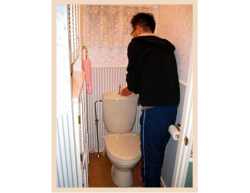
Todd Jay Leonard, Blog


This column marks the halfway point of "Todd's Top-10 List of Things Japanese." Over the past couple of months, I have been commenting on aspects of Japanese culture and daily life that I especially like.
Coming in at No. 5 on the list is a topic I've written about before but one that I feel needs to be covered again: Japanese toilets.
The Japanese have not only perfected the basic design of the hardware used in these items - they have magnificently transformed the mundane need for daily elimination into a surreal experience that makes visitors to this country swoon with contentment.
A case in point: In 2005, Madonna returned to Japan for a concert after a nearly 12-year absence. When she met with entertainment reporters at a press conference, she commented to the packed room that she had missed terribly Japan's warm toilet seats. This remark caused the attendees to chuckle, knowing exactly what she meant.
A nice, warm feeling
Living in a cold climate (as I do here) makes having an electric toilet seat that stays warm a necessity and not a mere indulgence. For people who take for granted central heating, it might seem like a superfluous extravagance to have a heated toilet seat.
However, to those of us without the luxury of central heating, it is indeed a welcome salutation first thing in the morning upon waking up from a night's sleep. Being greeted with a toasty-warm toilet seat rather than a burst of icy-cold plastic on one's derriere is much appreciated - trust me.
Western-style toilets were not generally used in Japan until well after World War II had finished and Japan was forging ahead in becoming a first-world, industrialized and modern nation. Once it became trendy to have and use Western-style toilets, Japanese commode makers immediately started to improve upon the original design, making them more versatile and practical for widespread use in Japanese homes.
Making the most of it
For instance, a standard feature on Japanese toilets is a sink that is built into the design of the lid on the toilet tank. Instead of having a separate sink to wash one's hands after using the facilities, a small basin and faucet can be found on most Japanese toilets. When it is flushed, the clean water washes the person's hands, filling the tank, which will then be used by the next person to flush the waste away.
This is an ingenious design, saving water and making the toilet multi-functional. A towel rack is often positioned to the side of the toilet, in order for the users to dry their hands after rinsing them in the water that fills the tank.
Recently, a friend from Indiana came to visit me here and was especially impressed with this feature of the toilet ... as well as the heated toilet seat. She made a point to photograph the toilet in my home to show her husband, commenting that it was such an efficient use of water.
I have to agree with her. It is more environmentally sound, and makes perfect sense to have a double-use for the water that will eventually be flushed away.
The utmost in privacy
Most toilets in Japanese homes are in separate rooms, away from the bathtub and sink used for bathing and washing one's face and brushing one's teeth. A small room called a "senmenjo" (which usually doubles as a laundry room with a washing machine) is where people wash their face, hands, and brush their teeth. Next to this washbasin room is the "ofuro" or bathroom. I will write more upon the Japanese-style bath in my next column, which is No. 6 on my list of things I like about Japan.
When I first visited Japan in the late 1970s, it was common to see the letters "W.C." on all lavatory doors to toilets. This acronym was borrowed from Great Britain, short for "water closet," which labeled the toilet room.
The W.C. is considered by Japanese to be much too dirty to be combined with washing and grooming oneself, so it is nearly always separate. The one exception is in many efficiency apartments which utilize a "unit bath" - an entire bathroom including toilet, sink and tub in premolded pieces. Also, Western-style hotel rooms often have all-in-one bathrooms.
Having lived in Japan for nearly 20 years, though, I have to say that I like having the commode completely separate from the bath and sink-basin. It just makes hygienic sense to keep the two functions isolated from one another.
Studies have shown that anytime a toilet is flushed, it sends small particles of waste from the flushed water out into the air. If toothbrushes, towels, soap, and a bathtub are in the same room, these items get covered in this sullied mist.
I have noticed that some new homes in the United States are beginning to separate the two areas of the bathroom by isolating the toilet in its own little room. A welcome change in house design, for sure.
Japanese are so finicky about cross-contamination from the toilet that special slippers are even provided for guests to use while in the toilet. These are usually plastic, making them easy to clean, and are worn only in the toilet room.
These slippers will sometimes have the letters "W.C." on them, so if someone forgets to take off the "toilet" slippers after using the facilities, everyone will know. An embarrassing situation indeed, especially at a dinner party, when the host has to point out to a guest that he/she forgot to change back into the regular house-slippers after using the toilet.
Old is new again
The current rage in Japan is the "washlet" or bidet-style toilet. These are very high-tech and are now being placed in public restrooms all over Japan in department stores, office buildings and restaurants. Most homes built in the last 15-20 years have as a standard feature this function on the family toilet.
These are nothing new, first introduced to Japan in 1964 by - believe it or not - an American company. However, after just two years on the Japanese market, the "Wash Air Seat" went into domestic production, and the rest is history. Virtually unheard of in the United States today, these types of toilets are now standard features here. And how they have evolved over the past 40 years!
An American friend who has lived in Thailand for 30 years came to visit me last December. We were touring Tokyo and staying at a very reasonably priced hotel. Even this modest hotel had installed in each room one of the fancier models of these bidet-style toilets.
My friend was so impressed with all the bells and whistles included on his hotel room toilet - heated seat, temperature- and pressure-controlled water for the derriere and a separate mode for women to use - he jokingly said he could forgo seeing Tokyo in order to stay in his room to enjoy the toilet. He was determined to get these washlet toilets installed in his home in Bangkok.
His reaction is typical for the uninitiated. Japanese bidet-toilets are certainly spoiling, and once a person has experienced one of these new-fangled contraptions, ordinary toilets just seem, well, humdrum.
Thrones fit for a king
However, this type of luxury comes at a hefty price. This is no deterrent to Japanese people who gladly fork out the money to have these installed in their homes. Just like Americans who think they can't live without a refrigerator with a water dispenser and icemaker on the door, automatic dishwasher or garbage disposal in the kitchen, Japanese people feel the same way about their washlet toilets. Rarely do Japanese kitchens have any of the amenities just mentioned that are typically found in American kitchens, but the majority of toilets in Japan are "washlets."
Home builders regularly, as a matter of course, include an additional hookup for water for these in new bathrooms, and an electrical socket can be found behind all toilets to plug in the heated seat. Some of the swankier models come with a remote so the user doesn't have to twist around to fumble with all the buttons found on the side of the toilet seat.
I know that Americans would embrace this technology in a New York minute - if the price would come down. Few Americans want to pay $800-$1,000 for a toilet seat. Interestingly, luxury options when purchasing a car is something that most Americans don't flinch at, choosing comfort and style over pure function.
Why not let this attitude extend to the one place where people do spend a goodly amount of time on a daily basis? It is well worth the high price, and once you try one of these high-tech toilets, you'll never be satisfied with the common, run-of-the-mill toilet ever again.
By TODD JAY LEONARD
Columnist
The hot seat
Visitors warm to luxurious Japanese toilets
Monday, June 4 , 2007







